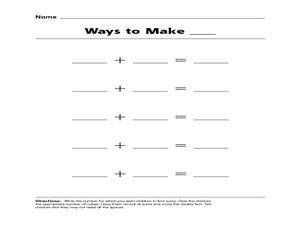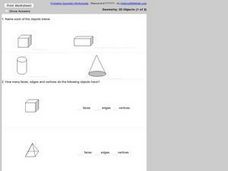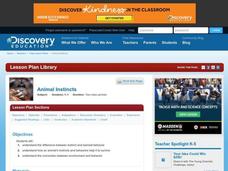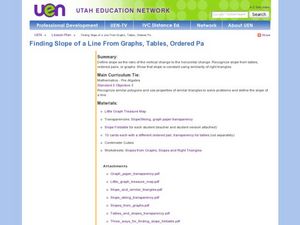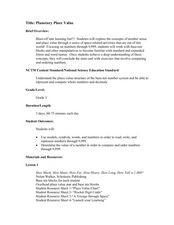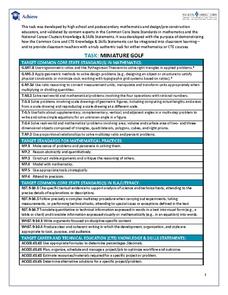Curated OER
"th" numbers
Second graders practice the code in English for fraction is that the words end in "th." They write and solve problems involving halves, quarters, thirds and fifths as they realize that the meaning of fraction words one "x-th" is that it...
Curated OER
Math Organizer: Way to Make a Sum
For this sums worksheet, students write 5 ways to make a given sum. Worksheet is a generic graphic organizer with a blank space at the top to write the sum being asked for.
Curated OER
Yoruba Naming Ceremony
Students, after identifying the history of their own names, write a sentence describing how their name is similar or different to Yoruba studenT names.
Curated OER
Create a Cloud in a Bottle
Students observe an experiment showing the formation of a cloud. They write a paragraph summarizing the condition that are necessary for a cloud to form and explain the weather situations cause cloud formation.
Curated OER
Richard's Dice
Students problem solve logic problems. They complete a worksheet using dice as a manipulative. They decide on a problem solving strategy, solve the problem, and write up the solution.
Curated OER
Shapes
Students examine various shapes and discover each part is the total of counterparts. In groups, they combine parts to equal a whole and divide numerous shapes into various parts. They practice drawing shapes and writing them in a...
Curated OER
Patterns
Second graders create an ABAB pattern with their name. In this early elementary math instructional activity, 2nd graders first model their names in an ABAB pattern with unifix cubes. They then recreate the pattern using letter stamps on...
Curated OER
Adequate Standard of Living: Children's Rights
Students and parents participate in a variety of activities designed to explore the issue of every person's right to adequate housing. They make butter, make models of different types of housing, read books, discuss the rights and...
Curated OER
Geometry: 3D Objects
In this math worksheet, learners examine 4 pictures of 3D objects and write the name of each. Students then study 3 pictures and figure the number of faces, edges and vertices on each.
Curated OER
Mechanical, Electrical and Radiant Energy
Students write a hypothesis and complete a lab. In this investigative lesson students complete their lab and a worksheet about energy.
Curated OER
Animal Instincts
Students compare animal adaptations to human behavior. In this science lesson, students discuss animal instincts vs. learned behavior. Options for student writing, drawing and research are incorporated into this lesson plan
Curated OER
Reaching Students through Literacy Centers
Continue the celebration of literacy this month by integrating reading centers into the classroom.
Curated OER
Bubble and Boyle
Even middle schoolers still enjoy experimenting with bubbles! They execute a series of experiments enabling them to distinguish between convex and concave surfaces, explore the properties of buoyancy, surface tension, and density,...
Mathed Up!
2D and 3D Shapes
What a great assessment to give young mathematicians in order to test their knowledge on two- and three-dimensional shapes. Learners name various shapes, identify the number of edges, faces, and vertices, match an unfolded version of a...
Alabama Learning Exchange
Finding Prime
Fifth and sixth graders explore prime numbers. They work with a partner to build rectangular arrays using twelve tiles. Factor pairs are noted and recorded on graph paper. Pupils construct rectangular arrays with a prime number and...
Utah Education Network (UEN)
Finding Slope of a Line from Graphs, Tables, and Ordered Pairs
Middle schoolers explore the concept of slope in numerous ways and start to look at simple linear equations. They describe the slope in a variety of ways such as the steepness of a line, developing a ratio, using graphs, using similar...
Curated OER
Is Bigger Always Better?
Explore rational numbers with the young mathematicians in your class. They will investigate decimals, fractions, and percents before ordering and comparing rational numbers. This multi-day unit includes differentiation activities and...
Curated OER
It's All in the Measurements
Study customary measurements with your sixth graders. They will investigate linear and capacity measurements to then measure and convert linear and capacity units. Finally they will work in small groups to conduct experiments. Resources...
Curated OER
Planetary Place Value
Third graders explore place value to the ten thousands place. This incredibly thorough, 24-page lesson has learners construct, order, and compare numbers to 9,999. This three-day lesson includes reteaching and extension activities...
Curated OER
Task: Miniature Golf
"Fore!" All right, no one really yells this out in miniature golf, but this well-defined activity will have your charges using lots of numbers in their unique design of a miniature golf hole. Included in the activity criteria is the...
National Math + Science Initative
Introduction to Decimals
Three activities make up an introductory lesson designed to create a strong foundation in comparing fractions to decimals and exploring and building decimal models. Pupils brainstorm and complete a Venn diagram to show how decimals and...
Curated OER
Moose Juice
Math can be delicious with a fun smoothie activity! Kids count the number of fruits that go into a smoothie in an activity activity, draw the fruit in the blender, and complete the addition problem on the side. Each page increases in...
Curated OER
Classifying Three-Dimensional Shapes
Compare geometric solids based on their properties. Your emergent geometers use spaghetti and marshmallows to build models so they can examine the number of faces, edges, and vertices on polyhedra of their own creation. Resource includes...
EngageNY
Stretching and Shrinking Graphs of Functions
Why is that graph wider? Pupils learn about stretching and shrinking graphs of square root, absolute value, cubic, and quadratic functions. They study both vertical and horizontal stretches and shrinks in addition to reflections.



